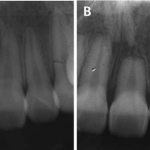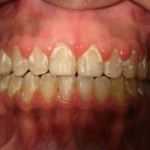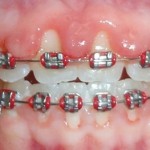Changes in the shape of the face, jaw and cheekbones may occur as a result of braces. It is important for a patient to discuss these potential changes before starting treatment.
Plaque forms easily when food is retained in and around braces. It is important to maintain proper oral hygiene by brushing and flossing thoroughly when wearing braces to prevent tooth decay, decalcification, or unpleasant color changes to the teeth.
There is a small chance of allergic reaction to the elastics or to the metal used in braces. It is important for those who believe that they are allergic to their braces to notify the orthodontist immediately.
Mouth sores may be triggered by irritation from components of the braces. Many products can increase comfort, including oral rinses, dental wax or, and products to help heal sores.
Braces can also be damaged if proper care is not taken. It is important to wear a mouth guard to prevent breakage and/or mouth injury when playing sports. Certain sticky or hard foods such as crabs, raw carrots, and toffee should be avoided because they can damage braces. Frequent damage to braces can prolong treatment.
In the course of treatment orthodontic brackets may pop off due to the forces involved, or due to cement weakening over time. The orthodontist should be contacted immediately for advice if this occurs. In most cases the bracket is replaced.
When teeth move, the end of the arch wire may become displaced, causing it to poke the back of the patient’s cheek. Dental wax can be applied to cushion the protruding wire.
Patients with periodontal disease usually must obtain periodontal treatment before getting braces. A deep cleaning is performed, and further treatment may be required before beginning orthodontic treatment. Bone loss due to periodontal disease may lead to tooth loss during treatment.
In some cases, teeth may be loose for a prolonged period of timeThe dental displacement obtained with the orthodontic appliance determines in most cases some degree of root resorption. Only in a few cases is this side effect large enough to be considered real clinical damage to the tooth. In rare cases, the teeth may fall out or have to be extracted due to root resorption.
Pain and discomfort are common after adjustment and may cause difficulty eating for a time, often a couple of days. During this period, eating soft foods can help avoid additional pressure on teeth.
Removal of the cemented brackets can also be painful. The cement must be chipped and scraped off which can cause severe pain in patients with sensitive teeth.
 Root resorption |
 Decalcification |
 Gum disease |
 Gum infection |